2.2.7: Angles of Elevation and Depression
- Page ID
- 14950
\( \newcommand{\vecs}[1]{\overset { \scriptstyle \rightharpoonup} {\mathbf{#1}} } \)
\( \newcommand{\vecd}[1]{\overset{-\!-\!\rightharpoonup}{\vphantom{a}\smash {#1}}} \)
\( \newcommand{\id}{\mathrm{id}}\) \( \newcommand{\Span}{\mathrm{span}}\)
( \newcommand{\kernel}{\mathrm{null}\,}\) \( \newcommand{\range}{\mathrm{range}\,}\)
\( \newcommand{\RealPart}{\mathrm{Re}}\) \( \newcommand{\ImaginaryPart}{\mathrm{Im}}\)
\( \newcommand{\Argument}{\mathrm{Arg}}\) \( \newcommand{\norm}[1]{\| #1 \|}\)
\( \newcommand{\inner}[2]{\langle #1, #2 \rangle}\)
\( \newcommand{\Span}{\mathrm{span}}\)
\( \newcommand{\id}{\mathrm{id}}\)
\( \newcommand{\Span}{\mathrm{span}}\)
\( \newcommand{\kernel}{\mathrm{null}\,}\)
\( \newcommand{\range}{\mathrm{range}\,}\)
\( \newcommand{\RealPart}{\mathrm{Re}}\)
\( \newcommand{\ImaginaryPart}{\mathrm{Im}}\)
\( \newcommand{\Argument}{\mathrm{Arg}}\)
\( \newcommand{\norm}[1]{\| #1 \|}\)
\( \newcommand{\inner}[2]{\langle #1, #2 \rangle}\)
\( \newcommand{\Span}{\mathrm{span}}\) \( \newcommand{\AA}{\unicode[.8,0]{x212B}}\)
\( \newcommand{\vectorA}[1]{\vec{#1}} % arrow\)
\( \newcommand{\vectorAt}[1]{\vec{\text{#1}}} % arrow\)
\( \newcommand{\vectorB}[1]{\overset { \scriptstyle \rightharpoonup} {\mathbf{#1}} } \)
\( \newcommand{\vectorC}[1]{\textbf{#1}} \)
\( \newcommand{\vectorD}[1]{\overrightarrow{#1}} \)
\( \newcommand{\vectorDt}[1]{\overrightarrow{\text{#1}}} \)
\( \newcommand{\vectE}[1]{\overset{-\!-\!\rightharpoonup}{\vphantom{a}\smash{\mathbf {#1}}}} \)
\( \newcommand{\vecs}[1]{\overset { \scriptstyle \rightharpoonup} {\mathbf{#1}} } \)
\( \newcommand{\vecd}[1]{\overset{-\!-\!\rightharpoonup}{\vphantom{a}\smash {#1}}} \)
\(\newcommand{\avec}{\mathbf a}\) \(\newcommand{\bvec}{\mathbf b}\) \(\newcommand{\cvec}{\mathbf c}\) \(\newcommand{\dvec}{\mathbf d}\) \(\newcommand{\dtil}{\widetilde{\mathbf d}}\) \(\newcommand{\evec}{\mathbf e}\) \(\newcommand{\fvec}{\mathbf f}\) \(\newcommand{\nvec}{\mathbf n}\) \(\newcommand{\pvec}{\mathbf p}\) \(\newcommand{\qvec}{\mathbf q}\) \(\newcommand{\svec}{\mathbf s}\) \(\newcommand{\tvec}{\mathbf t}\) \(\newcommand{\uvec}{\mathbf u}\) \(\newcommand{\vvec}{\mathbf v}\) \(\newcommand{\wvec}{\mathbf w}\) \(\newcommand{\xvec}{\mathbf x}\) \(\newcommand{\yvec}{\mathbf y}\) \(\newcommand{\zvec}{\mathbf z}\) \(\newcommand{\rvec}{\mathbf r}\) \(\newcommand{\mvec}{\mathbf m}\) \(\newcommand{\zerovec}{\mathbf 0}\) \(\newcommand{\onevec}{\mathbf 1}\) \(\newcommand{\real}{\mathbb R}\) \(\newcommand{\twovec}[2]{\left[\begin{array}{r}#1 \\ #2 \end{array}\right]}\) \(\newcommand{\ctwovec}[2]{\left[\begin{array}{c}#1 \\ #2 \end{array}\right]}\) \(\newcommand{\threevec}[3]{\left[\begin{array}{r}#1 \\ #2 \\ #3 \end{array}\right]}\) \(\newcommand{\cthreevec}[3]{\left[\begin{array}{c}#1 \\ #2 \\ #3 \end{array}\right]}\) \(\newcommand{\fourvec}[4]{\left[\begin{array}{r}#1 \\ #2 \\ #3 \\ #4 \end{array}\right]}\) \(\newcommand{\cfourvec}[4]{\left[\begin{array}{c}#1 \\ #2 \\ #3 \\ #4 \end{array}\right]}\) \(\newcommand{\fivevec}[5]{\left[\begin{array}{r}#1 \\ #2 \\ #3 \\ #4 \\ #5 \\ \end{array}\right]}\) \(\newcommand{\cfivevec}[5]{\left[\begin{array}{c}#1 \\ #2 \\ #3 \\ #4 \\ #5 \\ \end{array}\right]}\) \(\newcommand{\mattwo}[4]{\left[\begin{array}{rr}#1 \amp #2 \\ #3 \amp #4 \\ \end{array}\right]}\) \(\newcommand{\laspan}[1]{\text{Span}\{#1\}}\) \(\newcommand{\bcal}{\cal B}\) \(\newcommand{\ccal}{\cal C}\) \(\newcommand{\scal}{\cal S}\) \(\newcommand{\wcal}{\cal W}\) \(\newcommand{\ecal}{\cal E}\) \(\newcommand{\coords}[2]{\left\{#1\right\}_{#2}}\) \(\newcommand{\gray}[1]{\color{gray}{#1}}\) \(\newcommand{\lgray}[1]{\color{lightgray}{#1}}\) \(\newcommand{\rank}{\operatorname{rank}}\) \(\newcommand{\row}{\text{Row}}\) \(\newcommand{\col}{\text{Col}}\) \(\renewcommand{\row}{\text{Row}}\) \(\newcommand{\nul}{\text{Nul}}\) \(\newcommand{\var}{\text{Var}}\) \(\newcommand{\corr}{\text{corr}}\) \(\newcommand{\len}[1]{\left|#1\right|}\) \(\newcommand{\bbar}{\overline{\bvec}}\) \(\newcommand{\bhat}{\widehat{\bvec}}\) \(\newcommand{\bperp}{\bvec^\perp}\) \(\newcommand{\xhat}{\widehat{\xvec}}\) \(\newcommand{\vhat}{\widehat{\vvec}}\) \(\newcommand{\uhat}{\widehat{\uvec}}\) \(\newcommand{\what}{\widehat{\wvec}}\) \(\newcommand{\Sighat}{\widehat{\Sigma}}\) \(\newcommand{\lt}{<}\) \(\newcommand{\gt}{>}\) \(\newcommand{\amp}{&}\) \(\definecolor{fillinmathshade}{gray}{0.9}\)Angles going up or down from a horizontal line of sight.
Angles of Elevation and Depression
You have decided to go camping with some friends. While out on a hike, you reach the top of a ridge and look down at the trail behind you. In the distance, you can see your camp. You're thinking about how far you've traveled, and wonder if there is a way to determine it.
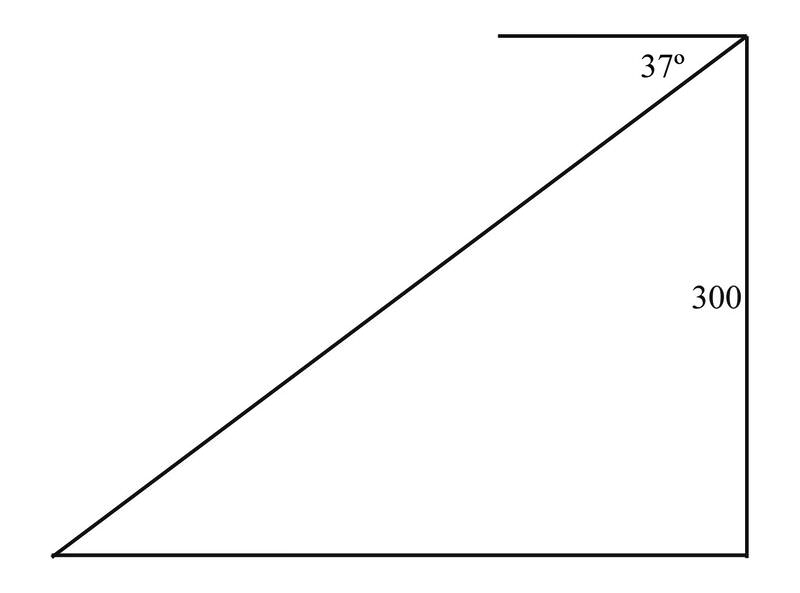
By using a small device called a clinometer, you're able to measure the angle between your horizontal line of sight and the camp as \(37^{\circ}\), and you know that the hill you just hiked up has a height of 300 m. Is it possible to find out how far away your camp is using this information? (Assume that the trail you hiked is slanted like the side of a triangle.)
Angles of Elevation and Depression
You can use right triangles to find distances, if you know an angle of elevation or an angle of depression.
The figure below shows each of these kinds of angles.
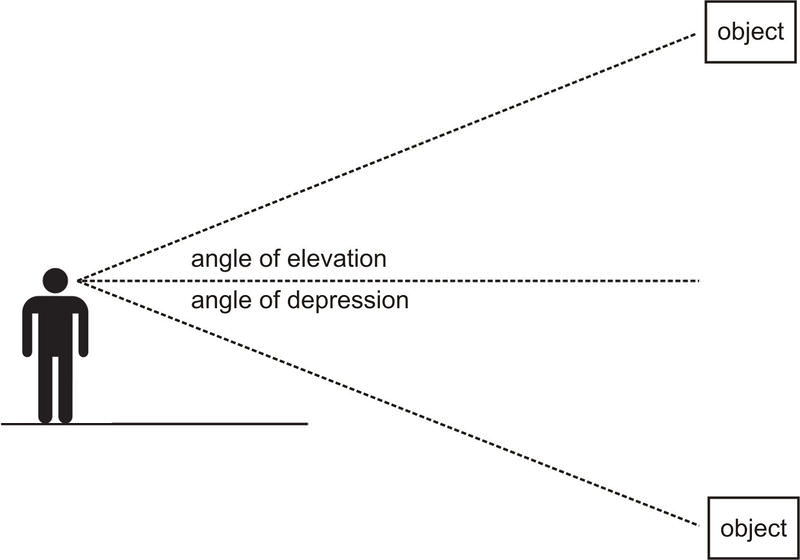
The angle of elevation is the angle between the horizontal line of sight and the line of sight up to an object. For example, if you are standing on the ground looking up at the top of a mountain, you could measure the angle of elevation. The angle of depression is the angle between the horizontal line of sight and the line of sight down to an object. For example, if you were standing on top of a hill or a building, looking down at an object, you could measure the angle of depression. You can measure these angles using a clinometer or a theodolite. People tend to use clinometers or theodolites to measure the height of trees and other tall objects. Here we will solve several problems involving these angles and distances.
Finding the angle of elevation
You are standing 20 feet away from a tree, and you measure the angle of elevation to be \(38^{\circ}\). How tall is the tree?
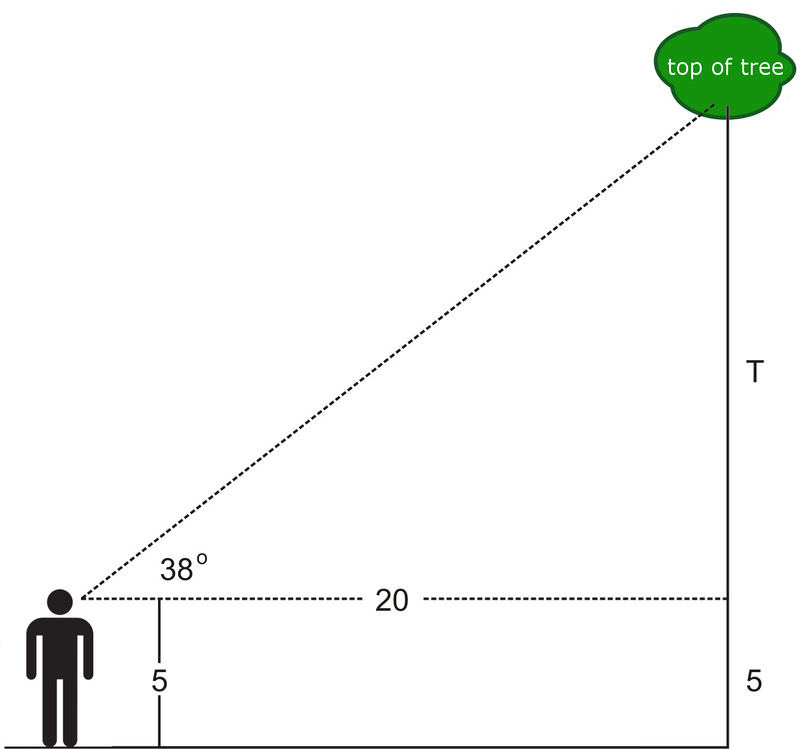
The solution depends on your height, as you measure the angle of elevation from your line of sight. Assume that you are 5 feet tall.
The figure shows us that once we find the value of \(T\), we have to add 5 feet to this value to find the total height of the triangle. To find \(T\), we should use the tangent value:
\(\begin{aligned} tan38^{\circ}&=\dfrac{\text{opposite}}{\text{adjacent}}=\dfrac{T}{20} \\ tan38^{\circ}&=\dfrac{T}{20}\\ T&=20tan38^{\circ}\approx 15.63\\ \text{Height of tree}&\approx 20.63 \text{ ft}\end{aligned}\)
You are standing on top of a building, looking at a park in the distance. The angle of depression is 53^{\circ} . If the building you are standing on is 100 feet tall, how far away is the park? Does your height matter?
Finding the angle of depression
If we ignore the height of the person, we solve the following triangle:
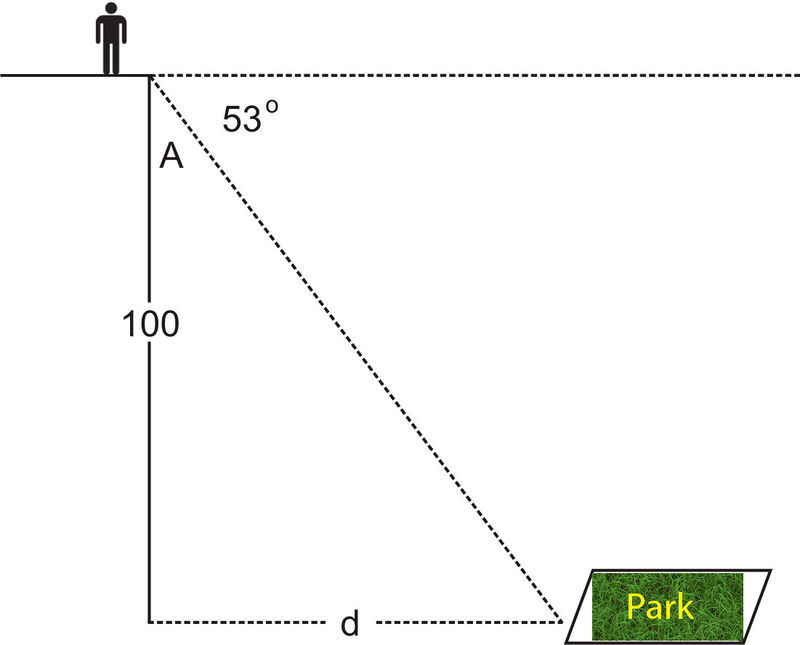
Given the angle of depression is \(53^{\circ}\), \(\angle A\) in the figure above is \(37^{\circ}\). We can use the tangent function to find the distance from the building to the park:
\(\begin{aligned} tan 37^{\circ}=\dfrac{\text{opposite}}{\text{adjacent}}=\dfrac{d}{100}\\ tan37^{\circ} &=\dfrac{d}{100}\\d&=100 tan37^{\circ} \approx 75.36\text{ ft} \end{aligned}\)
If we take into account the height if the person, this will change the value of the adjacent side. For example, if the person is 5 feet tall, we have a different triangle:
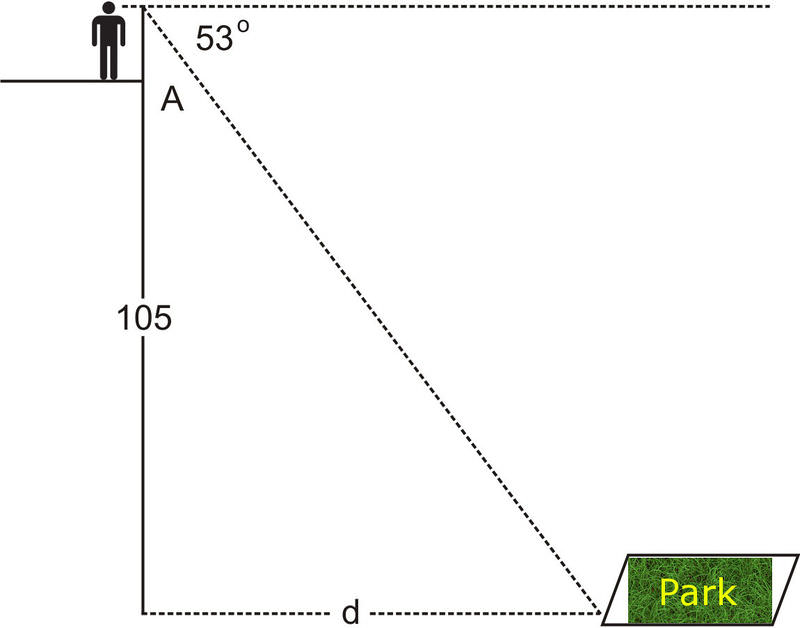
\(\begin{aligned} tan37^{\circ}&=\dfrac{\text{opposite}}{\text{adjacent}}=\dfrac{d}{105} \\ tan37^{\circ} &=\dfrac{d}{105} \\ d&=105{tan37^{\circ} \approx 79.12\text{ ft}\end{aligned}\)
If you are only looking to estimate a distance, then you can ignore the height of the person taking the measurements. However, the height of the person will matter more in situations where the distances or lengths involved are smaller. For example, the height of the person will influence the result more in the tree height problem than in the building problem, as the tree is closer in height to the person than the building is.
Real-World Application: The Horizon
You are on a long trip through the desert. In the distance you can see mountains, and a quick measurement tells you that the angle between the mountaintop and the ground is \(13.4^{\circ}\). From your studies, you know that one way to define a mountain is as a pile of land having a height of at least 2,500 meters. If you assume the mountain is the minimum possible height, how far are you away from the center of the mountain?

\(\begin{aligned} tan 13.4^{\circ}&=\dfrac{\text{opposite}}{\text{adjacent}}=\dfrac{2500}{d}\\ tan 13.4^{\circ} &=\dfrac{2500}{d} \\ d&=\dfrac{2500}{tan13.4^{\circ}} \approx 10,494 meters \end{aligned}\)
Earlier, you were asked if it was possible to find out how far away your camp is using the information given.
Solution
Since you know the angle of depression is \(37^{\circ}\), you can use this information, along with the height of the hill, to create a trigonometric relationship:

Since the unknown side of the triangle is the hypotenuse, and you know the opposite side, you should use the sine relationship to solve the problem:
\(\begin{aligned} sin37^{\circ}&=\dfrac{300}{hypotenuse} \\ hypotenuse&=\dfrac{300}{sin37^{\circ} }\\ hypotenuse &\approx 498.5\end{aligned}\)
You have traveled approximately 498.5 meters up the hill.
You are six feet tall and measure the angle between the horizontal and a bird in the sky to be 40^{\circ} . You can see that the shadow of the bird is directly beneath the bird, and 200 feet away from you on the ground. How high is the bird in the sky?
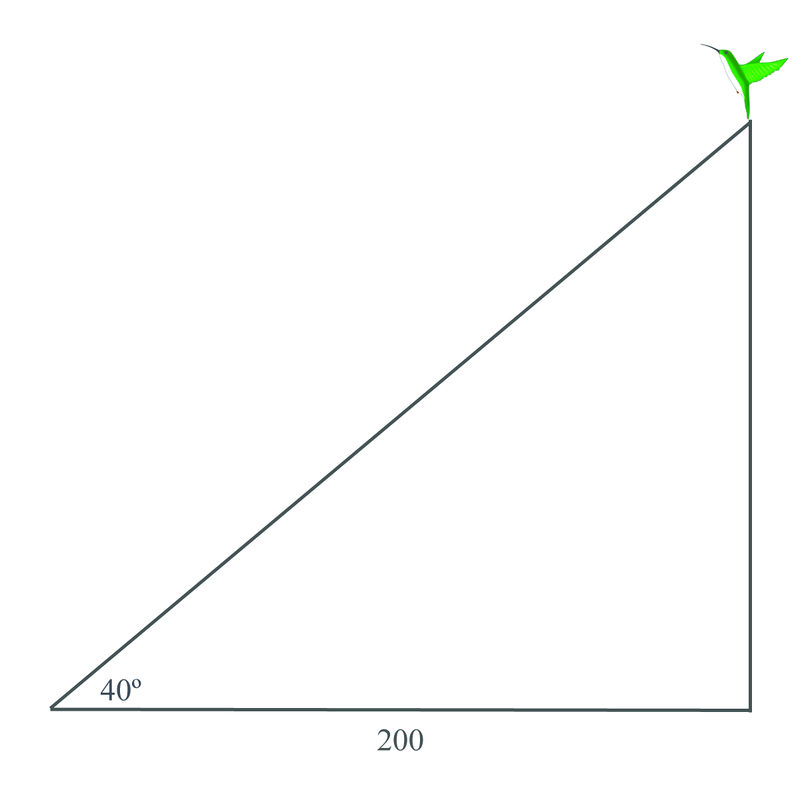
Solution
We can use the tangent function to find out how high the bird is in the sky:
\(\begin{aligned} tan40^{\circ} =\dfrac{height}{200} \\ height&=200 tan40^{\circ} \\ height&=(200)(.839) \\height&=167.8\end{aligned}\)
We then need to add your height to the solution for the triangle. Since you are six feet tall, the total height of the bird in the sky is 173.8 feet.
While out swimming one day you spot a coin at the bottom of the pool. The pool is ten feet deep, and the angle between the top of the water and the coin is \(15^{\circ}\). How far away is the coin from you along the bottom of the pool?
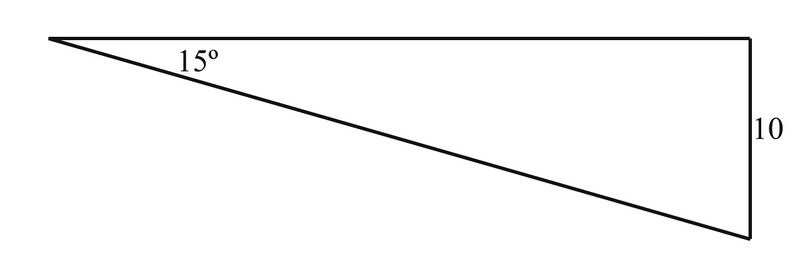
Solution
Since the distance along the bottom of the pool to the coin is the same as the distance along the top of the pool to the coin, we can use the tangent function to solve for the distance to the coin:
\(\begin{aligned} tan15^{\circ}&=\dfrac{\text{opposite}}{\text{adjacent}} \\ tan 15^{\circ} =\dfrac{10}{x} \\ x&=\dfrac{10}{tan15^{\circ}} \\ x&\approx 37.32^{\circ}\end{aligned}\)
You are hiking and come to a cliff at the edge of a ravine. In the distance you can see your campsite at the base of the cliff, on the other side of the ravine. You know that the distance across the ravine is 500 meters, and the angle between your horizontal line of sight and your campsite is \(25^{\circ}\). How high is the cliff? (Assume you are five feet tall.)

Solution
Using the information given, we can construct a solution:
\(\begin{aligned} tan 25^{\circ} =\dfrac{\text{opposite}}{\text{adjacent}}\\ tan25^{\circ}&=\dfrac{height}{500} \\ height&=\dfrac{500}{tan25^{\circ}}\\ height&=(500)(.466) \\ height&=233\text{ meters}\end{aligned}\)
This is the total height from the bottom of the ravine to your horizontal line of sight. Therefore, to get the height of the ravine, you should take away five feet for your height, which gives an answer of 228 meters.
Review
- A 70 foot building casts an 50 foot shadow. What is the angle that the sun hits the building?
- You are standing 10 feet away from a tree, and you measure the angle of elevation to be \(65^{\circ}\). How tall is the tree? Assume you are 5 feet tall up to your eyes.
- Kaitlyn is swimming in the ocean and notices a coral reef below her. The angle of depression is \(35^{\circ}\) and the depth of the ocean, at that point is 350 feet. How far away is she from the reef?
- The angle of depression from the top of a building to the base of a car is \(60^{\circ}\). If the building is 78 ft tall, how far away is the car?
- The Leaning Tower of Pisa currently “leans” at a \(4^{\circ}\) angle and has a vertical height of 55.86 meters. How tall was the tower when it was originally built?
- The angle of depression from the top of an apartment building to the base of a fountain in a nearby park is \(72^{\circ}\). If the building is 78 ft tall, how far away is the fountain?
- You are standing 15 feet away from a tree, and you measure the angle of elevation to be \(35^{\circ}\). How tall is the tree? Assume you are 5 feet tall up to your eyes.
- Bill spots a tree directly across the river from where he is standing. He then walks 18 ft upstream and determines that the angle between his previous position and the tree on the other side of the river is \(55^{\circ}\). How wide is the river?
- A 50 foot building casts an 50 foot shadow. What is the angle that the sun hits the building?
- Eric is flying his kite one afternoon and notices that he has let out the entire 100 ft of string. The angle his string makes with the ground is \(60^{\circ}\). How high is his kite at this time?
- A tree struck by lightning in a storm breaks and falls over to form a triangle with the ground. The tip of the tree makes a \(36^{\circ}\) angle with the ground 25 ft from the base of the tree. What was the height of the tree to the nearest foot?
- Upon descent an airplane is 15,000 ft above the ground. The air traffic control tower is 200 ft tall. It is determined that the angle of elevation from the top of the tower to the plane is \(15^{\circ}\). To the nearest mile, find the ground distance from the airplane to the tower.
- Tara is trying to determine the angle at which to aim her sprinkler nozzle to water the top of a 10 ft bush in her yard. Assuming the water takes a straight path and the sprinkler is on the ground 4 ft from the tree, at what angle of inclination should she set it?
- Over 3 miles (horizontal), a road rises 1000 feet (vertical). What is the angle of elevation?
- Over 4 miles (horizontal), a road rises 1000 feet (vertical). What is the angle of elevation?
Review (Answers)
To see the Review answers, open this PDF file and look for section 1.13.
Vocabulary
| Term | Definition |
|---|---|
| Angle of Depression | The angle of depression is the angle formed by a horizontal line and the line of sight down to an object when the image of an object is located beneath the horizontal line. |
| Angle of Elevation | The angle of elevation is the angle formed by a horizontal line and the line of sight up to an object when the image of an object is located above the horizontal line. |
Additional Resources
Video: Example: Determine What Trig Function Relates Specific Sides of a Right Triangle
Practice: Angles of Elevation and Depression

